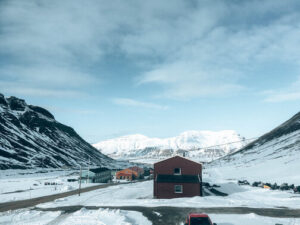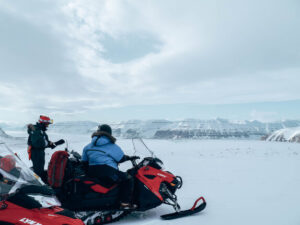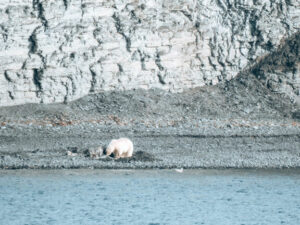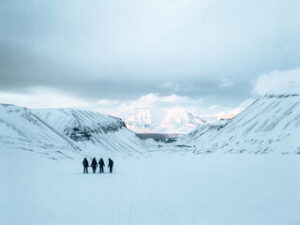Guest Blogger Myrthe Nijsten from Light Green Living wrote a guest blog for us about her travel to the Arctic and how it changed her life.
Sometimes you cross paths with someone with whom you click instantly. For us, this instant click was with Myrthe from Light Green Living. What’s in the name, right?! Not only does she strive for a greener world just like we do, but she is also a big fan of this beautiful world we have. Quickly after we met, she told us about her travel to the Arctic. Her stories captured our full attention! And, as Myrthe says herself: “How a travel to the Arctic changed my life”. Because this experience is too unique and too rare not to share, you are privileged to dive fully into Myrthe her experience:
Travel to the Arctic
“It all started back in August 2019. My bonus sister, Anne, was doing her Masters in Biology in Spitzbergen, Svalbard. Yes, Spitzbergen is an island of Norway. Before that time, if you would have asked me where it was, I would probably say somewhere in Germany? Little did I know how this travel to the Arctic was going to change my life.
Svalbard is the biggest of 5 towns in Spitzbergen with just a small amount of 2.000 inhabitants and is located at a 79° north latitude. Arriving in August meant summertime and thus no moon and no darkness. Very weird to wake up in the middle of the night and it more feels like 9 a.m. because of the daylight shining through your curtains.

Anne promised to show us around the next couple of 6 days and I never had imagined these 6 days changed my life, I would have never imagined what it would be like to travel to the Arctic…
Imagine yourself a place on earth with no hiking routes, a few main roads that you can ride by car, full of nature and wildlife. Yes, a trip to the Arctic might be different than we commonly experience. Some of the most common wildlife here are Arctic Fox, reindeers, whales, and polar bears. Yes, you read it correctly, polar bears! Since 1973, the polar bear has been considered a protected species. For that reason, it is illegal to hunt, lure, disturb or feed a beer.

While hiking and wandering around it is strongly advised to be accompanied by a guide or armed with a rifle. Anne got a permit from the governor of the town to carry a rifle, just in case. Although real confrontations between a polar bear and humans are not particularly common, most of the residents of Spitzbergen do go out armed just in case. To be in a place where all sorts of species living so close to each other just took my breath away. Just checking in: are you already doing your research on how to travel to the Arctic?
One day we decided to visit the Pyramiden, an abandoned Soviet coal mining settlement which nowadays is mostly used as a tourist destination. While you travel to the Arctic this is an absolute highlight! It is a 3-hour boat drive from Svalbard to Pyramiden. We hopped on a small boat with 10 other people and started our journey. Suddenly after an hour, the captain stopped the boat. A polar bear was located close to the shore where we were. How amazing is that! My heart pounded and the captain told us he could come a little bit closer. To not disturb the polar bear in his natural habitat we could see him with a very good binocular. He was feeding himself with a piece of a whale. Can you imagine seeing an animal like this in the wild?! You can imagine this moment and my travel to the Arctic was mind-blowing!

Anne told us that polar bears are struggling because of climate change. The period a year Spitzbergen is covered in ice becomes shorter and shorter. Polar bears depend on this sea ice because they use it to hunt seals, rest, and breed. Due to the warming climate, summer ice continues to decrease and is also melting for a longer period, which prevents polar bears from going out to get their food. They need to swim or walk long distances to keep up with the shrinking ice around them. This interested me to dive deeper into what climate change actually means and what kind of influence it has and will have on all of us.
For now, polar bears still outnumber the island’s inhabitants but for how long? Actually, the Arctic is very hard hit by climate change, more than anywhere else on earth. The ice is melting at an alarming rate. It appeared that since the pre-industrial time, temperatures have risen twice as fast as the global average! This phenomenon is called polar amplification.
You might think, what does polar amplification mean? Let me explain it to you briefly:
Normally, the reflectivity of ice in the Arctic should reflect 80% of the heat that comes from the sun back into space. However, when the world becomes warmer, there is way more heat from tropical areas at the poles which makes the ice melt. The surface becomes darker (because of the lack of ice) and absorbs more solar radiation, creating a sort of loop which creates more warmth. Also, other factors can worsen the situation, such as methane release, which is a powerful greenhouse gas, from the soil. All these factors make this region even more sensitive to climate change.

I can write a lot more about this topic but what I realized is that we have to start living in different ways. That is how a trip to the Arctic changed my life. Polar bears and a lot of other beautiful creatures can’t live without ice. It will raise our sea levels that will cause more flooding. More land will be underwater and there will be more places on earth where it is not safe to live anymore. If you have thought about a trip to the Arctic, it has to be in better conditions than those!
After seeing this beautiful nature in front of my eyes and hearing and reading about the circumstances that we are in, it touched my heart. After I came home, I immediately start looking into how I could live more sustainably. After 4 months, I stopped completely eating meat, reduced my shower time, shopped more second hand and thought twice about taking a car for traveling. And honestly, it’s not hard at all. A trip to the Arctic has changed my life, but maybe reading my story can change yours as well?
I still can write more than 100 pages, but by telling this story I hope you got some inspiration. To see and appreciate the beautiful world we are surrounded by. Not only in Spitzbergen but also in your own backyard. Just walk outside and just look around for one minute, just breathe and see all the magical things that are happening in front of your doorstep. For me, those are things worth fighting for. To make small changes within your own household you will contribute to a greener world! For those who have questions about their future travel to the Arctic or about this blog article, make sure to leave a comment.”

Written by: Myrthe Nijsten


